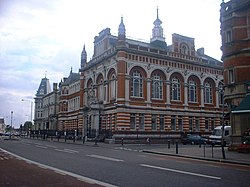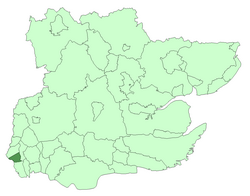Leyton Borough Council
| Leyton | |
|---|---|
 Leyton Town Hall |
|
 Leyton within Essex in 1961 |
|
| Area | |
| • 1901 | 2,594 acres (10.5 km2) |
| • 1931 | 2,594 acres (10.5 km2) |
| • 1961 | 2,595 acres (10.5 km2) |
| Population | |
| • 1901 | 98,912 |
| • 1931 | 128,313 |
| • 1961 | 93,959 |
| Density | |
| • 1901 | 38.1/acre |
| • 1931 | 49.5/acre |
| • 1961 | 36.2/acre |
| History | |
| • Origin | Leyton St Mary ancient parish |
| • Created | 1873 |
| • Abolished | 1965 |
| • Succeeded by | London Borough of Waltham Forest |
| Status |
Local government district (1873–1894) Urban district (1894–1926) Municipal borough (1926–1965) |
| Government | Leyton Local Board (1873–1894) Leyton Urban District Council (1894–1926) Leyton Borough Council (1926–1965) |
| • HQ | High Road, Leyton |
| • Motto | MINISTANDO DIGNITAS (Dignity in service) |
| Subdivisions | |
| • Type | Civil parishes |
| • Units | Leyton (1873–1965) Wanstead (part) (1883–1894) Cann Hall (1894–1965) |
Leyton was a local government district in southwest Essex, England, from 1873 to 1965. It included the neighbourhoods of Leyton, Leytonstone and Cann Hall. It was suburban to London, forming part of the London postal district and Metropolitan Police District. It now forms the southernmost part of the London Borough of Waltham Forest in Greater London.
Leyton St Mary or Low Leyton (sometimes spelt "Layton") was an ancient parish in the Becontree hundred of Essex, England. Originally, the parish had an area of 2,271 acres (919 hectares), which included a detached part to the north of 588 acres (238 hectares), separated from the main part of the parish by a long, narrow exclave of Walthamstow, known as the Walthamstow Slip. To the south, the parish of Wanstead formed a long protrusion known as the Wanstead Slip, which extended to the marshes of the River Lea and divided Leyton from West Ham.
Much of the early governance of the parish was in the hands of the lords of the manors of Leyton and Ruckholt, who held courts baron, a type of manorial court from the medieval period until the 1840s. The lords and their courts appointed public officers such as constables (from 1381), marsh haywards, ale tasters (from 1509), headboroughs (from 1578), tithingmen (from 1584) and a poundkeeper in 1796. They also decided rights of common, who was liable for maintaining roads and bridges, and for making and maintaining infrastructure such as animal pounds, lock ups and .
...
Wikipedia
